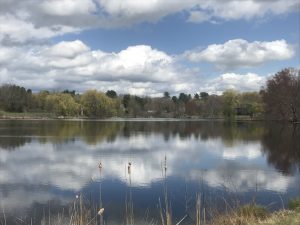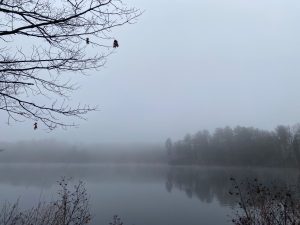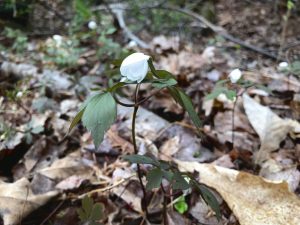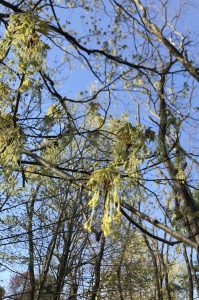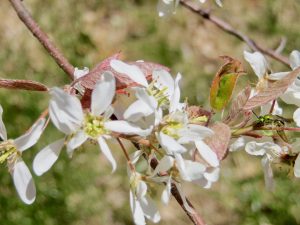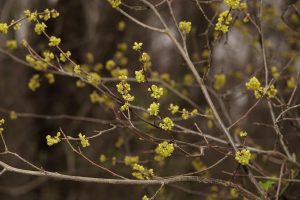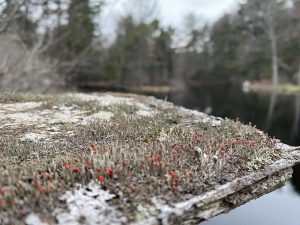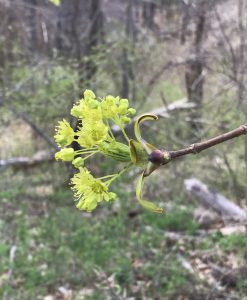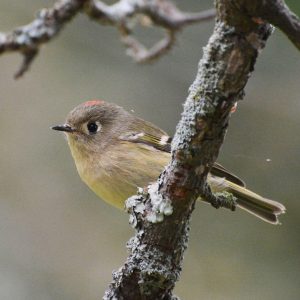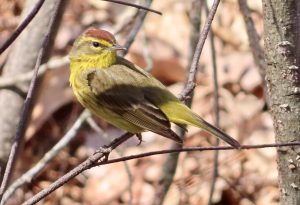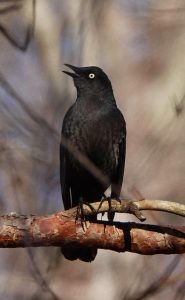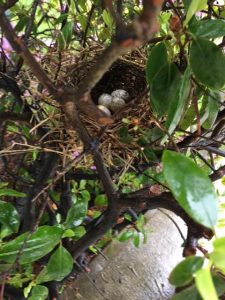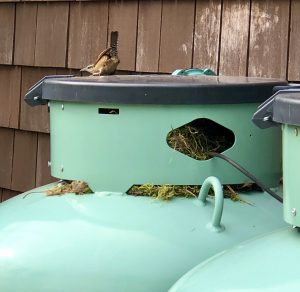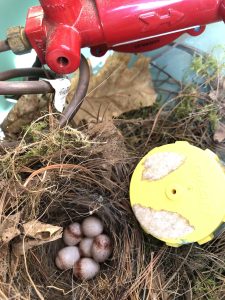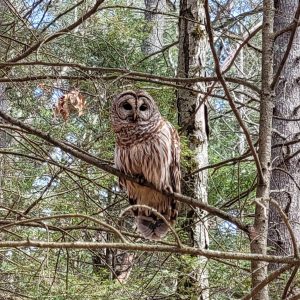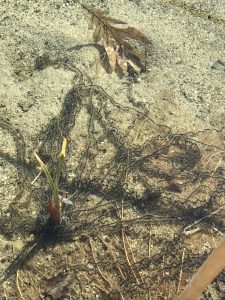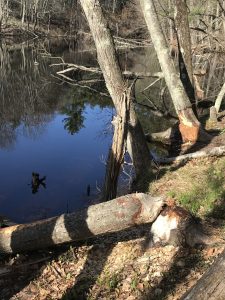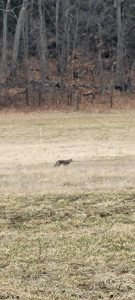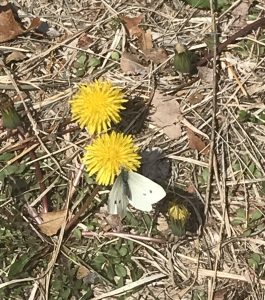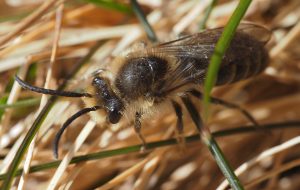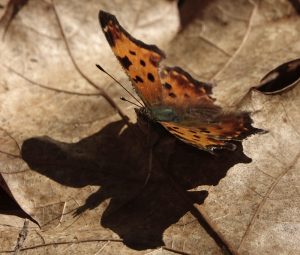Written by Gwyn Loud for the Lincoln Land Conservation Trust. She welcomes your sightings and questions at 781-259-8690 of gwynloud555@gmail.com
The landscape is greening before our eyes, with many trees and shrubs leafing out or flowering, and fields and lawns displaying emerald carpets, dotted with dandelions. April showers are supposed to bring May flowers, but the first three weeks of April were too dry. Luckily, showers as well as some downpours, provided much-needed water late in the month. We had a preview of summer on April 13 and 14 with record-high temperatures of 90℉- too hot! Trees such as sugar and Norway maples are flowering now, and on red maples we can admire hanging clusters of red winged seeds. In the woods, watch for shrubs such as spicebush and shadbush or wildflowers such as wood anemone. Over the next month Canada mayflower will carpet the forest floor and lady’s slippers will bloom. A common lichen called British solders, perhaps with a nod to Patriots’ Day, can be seen on stumps and rocks with its ‘redcoat’ fruiting body of spores. It is garlic mustard season; please continue to pull this invasive plant.
We have just celebrated Earth Day, which began back in 1970. There are many ways we can each do our bit to save our planet. Children in the LEAP program had ideas and you can see them posted in a window near the Twisted Tree. Margaret Renkl, whose writing about nature I admire, had an opinion piece on April 17 in the New York Times titled, Why Do You Still Have Lightning Bugs? Ours are all Gone in which she explains why she advocates refraining from using insecticides, even the supposedly “natural” ones, and turning off exterior lights after dark (see link below). Rethinking lawns is occurring nation-wide in the “No Mow May” movement. Many Lincoln homeowners will be participating by letting lawns grow longer to allow small flowering plants to bloom in the grass, thus benefiting early pollinators. Recently, the LLCT sent a “Seasonal Reference Guide” to all residents about how to support biodiversity and healthy ecosystems through climate-friendly gardening. If you have lost yours, check it out on the link below.
The spring bird migration is well underway, some arriving, some passing through, some winter residents departing. Dark-eyed juncos and white-throated sparrows, busy at our feeders all winter, will head north to breed. A website called BirdCast allows us to see avian migration from above and in real time! As Ty Burr writes in The New York Times Magazine, “Up to 3.5 billion birds and more than 600 species migrate across North America each spring, mostly at night, but usually we can see them only looking up from the ground. BirdCast lets us look down from above, and that changes everything. A joint project of the Cornell Lab of Ornithology, Colorado State University and U. Mass Amherst, it’s a website that lets us see them from a vantage point hundreds of miles above Earth, capturing each night’s continental migration as collected by over 140 radar stations across the country. “ Birders can check maps on the site to see if a specific night will be a big night over any given location. It is well known that thousands of migrating birds die by crashing into brightly lit tall buildings in cities. Happily, some cities have agreed to join the Lights Out program on nights when a big migration is forecast.
Locally, the chipping sparrows came back right “on time”, pine warblers, hermit thrushes, blue-gray gnatcatchers, mockingbirds, and gray catbirds, which all nest here, have returned, as have tree swallows, killdeer, and Eastern phoebes, brown-headed cowbirds, and Eastern towhees. Over the next few weeks many of our favorites will arrive such as Baltimore orioles, rose-breasted grosbeaks, barn swallows, and house wrens (not everyone’s favorite!). I shall put up my sugar-water feeder by May 1, as the next warm south wind could signal the arrival of the ruby-throated hummingbirds. Palm warblers are passing through now, and many more species of warblers will be here by mid-May, with most headed farther north to breed. Other species sighted recently, just passing through, included American pipets, ruby-crowned kinglets, fox and Savannah sparrows, and rusty blackbirds.
This is nesting season. Many residents reports bird houses occupied by bluebirds, with eggs just starting to hatch, and my neighbor has a Carolina wren nesting on top of a propane tank. House finches will often choose an old wreath on your door as a nesting spot, and phoebes seem to like ledges overhanging door ways. A resident at the Ryan Estates can see a Northern cardinal’s nest right from her window. Great-horned owls and barred owls should have young well along by now, and wood ducks are busy nesting in tree cavities or special wood duck boxes. Any day we can expect to see Canada geese swimming with a line of goslings between the two parents, keeping a watchful eye out for predators such as snapping turtles. Over a dozen mute swans continue on Farrar Pond, very visible from Rt. 117. Red-shouldered hawks must be nesting near Conant Rd. as I hear them calling a lot.
The migration of frogs and salamanders to lay eggs in their natal vernal pools occurred in March, apparently over several nights, as this year the conditions were not perfect for one “Big Night”. On any rainy night in spring amphibians can be on the roads as they make their way back to the woods for the rest of the year, so please drive watchfully. The wood frog eggs have hatched by now, meaning that thousands of tadpoles are swimming in vernal pools. They will grow legs, absorb their tails, and become adults fairly quickly, allowing them to hop away before their pool dries up in late summer. I am glad to learn that Conservation Department staff are working on certifying vernal pools, which will give them permanent protection. Green frogs can be heard making a banjo-like “plink” as they jump into the water and, when warmer weather comes, we will hear the deep jug-a-rum of bullfrogs, our largest frog. American toads began making their high trilling calls on April 15 and are laying eggs which look like strings of black pearls in shallow water. As for reptiles, painted turtles are easy to spot as they sit on logs and rocks at the surface of ponds, soaking up the sun’s warmth. Garter snakes and at least one water snake have been reported by many observers.
Mammal sightings have been of our “usuals” such as deer, red fox, fishers, squirrels, and one rabbit. My neighbor’s trail cam picked up a bobcat and, in the Rando swamp, a muskrat, beaver and two otters. Evidence of beavers at work is very noticeable in various places, including trees they have chewed down on the shore of the lower pond at Mt. Misery. It remains to be seen if this will be a summer with numerous chipmunks, but perhaps not, as last fall was a poor mast year, meaning that acorns were not very plentiful to supply winter food. Surely woodchucks are busy but, I am glad to say, not near my garden (so far!). I have not seen a striped skunk in a long time, either alive or as a roadkill, and would be interested to know what readers notice in that regard.
Insect life is thriving, now the warm weather has arrived. This is good news, as they are crucial in our ecosystems. Black flies are out and early butterflies such as Eastern commas and mourning cloaks have been seen as well as the very common cabbage white. Norman Levey, who observes bees carefully, reported watching small cellophane bees excavating nests in sandy soil and many bumble bees visiting willow flowers.
Last but not least, on a climate/action note, I hope that many readers will be willing to sign the petition in the link below opposing “Massport’s expansion plans for private luxury jet capacity at Hanscom Field, a project which will facilitate hundreds of thousands of tons of greenhouse gas emissions, in opposition to every Climate goal that our towns, our Commonwealth, and the nation are working arduously to achieve.” In terms of other environmental damage, the expansion would involve clearing trees and laying down great expanses of asphalt. Obviously, wildlife in the area would be very adversely affected.
Pertinent links:
To read Margaret Renkl’s essay, click here.
To learn more about No Mow May, visit lincolncommonground.com
To read the LLCT’s Seasonal Reference Guide, click here.
To learn more about bird migration maps and the Lights Out program: https://birdcast.info/science-


